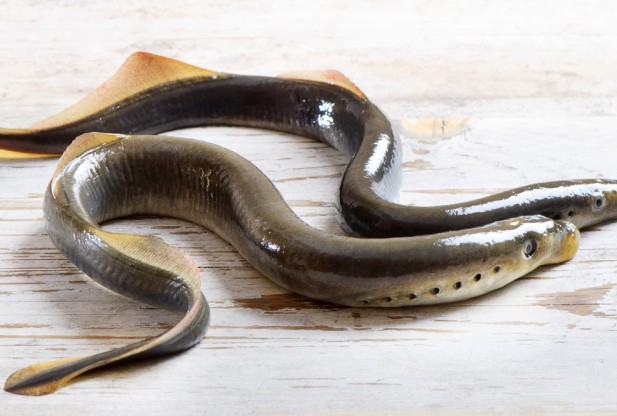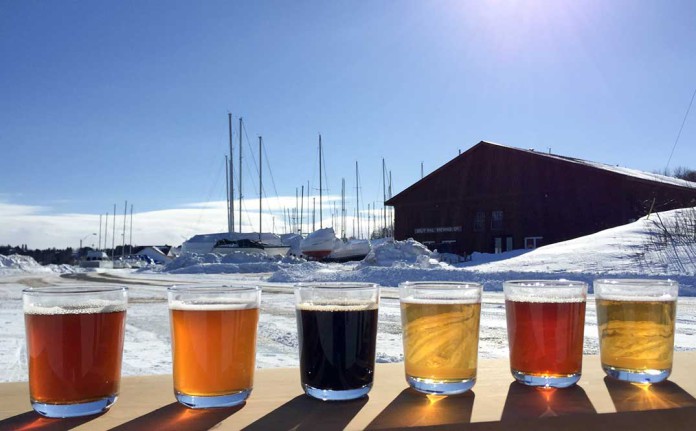GREAT LAKES—Man has tackled Mother Nature’s barriers to commerce with gusto ever since we descended from the forest canopy, and in the early days of the industrial revolution engineering developed methods of bypassing those barriers with the exponential exuberance—with a concurrent (and some might say arrogant) disregard and ignorance of the impact our efforts would have on the often delicate balance of her designs. So it was with the sea lamprey.
Luckily, man has discovered innovative ways to help control the explosive growth of the sea lamprey that have proved very successful. Now a new use for scents (pheromones to be more technically correct) promise even greater success.
Sea lampreys are native to the vast waters of the North Atlantic, but with the creation of artificial waterways to connect the St. Lawrence to the Great Lakes and the interior of the North American continent, the parasites inevitably found their way in as well.
Sea lampreys were first observed in Lake Ontario in the 1830s, but it was not until improvements to the Welland Canal in 1919 that these voracious parasites invaded Lake Erie, first observed in in those waters in 1921. After their spread into Lake Erie, sea lampreys moved swiftly to invade the other Great Lakes, appearing in Lake St. Clair in 1934, Lake Michigan in 1936, our own Lake Huron in 1937 and Lake Superior by 1938. By the late 1940s, sea lamprey populations had exploded in all of the upper Great Lakes causing severe damage to lake trout and other critical fish species.
Once it invaded the waters of the Great Lakes, the sea lamprey, with its voracious appetite and facing few natural controls or predators in these waters, the parasite’s numbers soon devastated the Great Lakes fisheries. To give an idea of the scale involved, by the 1940s lake trout harvests had plummeted from 18 million pounds a year to less than 300,000 pounds. It wasn’t only lake trout either, the sea lamprey sucked the life out of many other species (such as whitefish) as well.
In efforts to control sea lamprey numbers, and to protect the Great Lakes fisheries, millions of dollars were marshalled into research and practical efforts that brought the sea lamprey population down dramatically. Chief among those efforts has been the use of a pesticide that, entered into the waterways where the sea lamprey spawns, kills the creatures long before they stretch out their fins into the larger bodies of water.
“The odor larvae release says ‘we’re thriving here’,”
In 1955 the Integrated Sea Lamprey Control Program was established in order to tackle the issue. The joint program between Canada and the US has had great success in minimizing damage to Great Lakes fisheries and soon sea lamprey spawning had been reduced by about 90 percent. The program relied on a specific pesticide in conjunction with physical barriers on spawning streams and it proved very successful. Unfortunately, the pesticide was not entirely benign and has resulted in tragic losses of endangered species.
Sea lampreys have a very unique life cycle and it is in their adult phase where they cause the most damage to Great Lake fisheries. That adult phase lasts about 12-18 months. Adult lampreys die off during the spring, but first they swim up rivers to spawn. Once lamprey eggs hatch, the creatures go through a non-parasitic larval stage that lasts from three to six years, after that they enter the Great Lakes to feed upon the fish population. It is during the larval stage that sea lampreys are vulnerable to chemical control, but efforts also target the adults by interfering with their efforts to spawn successfully.
A key component of these new efforts to tackle the sea lamprey, in the words of Michigan State University fish ecologist Dr. Michael Wagner, “we are trying to move away from brute force techniques like pesticides and achieve the most environmentally friendly control of lampreys possible.”
Pheromones, those chemicals that animals and other critters use to get it together to get it on, have been used in the battle against lampreys for some time, but a new innovative study is honing those efforts right down to, well, a science.
It seems that lamprey use the scent of larvae to seek out the streams to spawn. Dr. Wagner notes that the scent of the larvae identify the best streams for their survival, thus the best places to deposit the future generation. “The odor larvae release says ‘we’re thriving here’,” noted the fish ecologist.
The male lamprey travel to the streams to construct nests before release their own ‘come hither’ chemicals to attract females with which to mate.
Another pheromone released by dead or injured lampreys warns would be lovers away from deadly environs.
Researchers now hope to utilize these push-me-pull-you pheromones to deliver a one-two punch to lamprey populations. By releasing artificial versions of these pheromones into the water of selected streams they can warn lampreys off of the best streams for reproduction while at the same time luring the unsuspecting lovers into less attractive neighbourhoods.
Currently, the new techniques have not found their way into the ‘wild’ as it were with local sea lamprey controls, according to Paul Sullivan, division manager at the Sea Lamprey Control Centre in Sault Ste. Marie, but they are eliciting some excitement about the future.
In previous years, the Mindemoya River, the Manitou River, Silver Creek, Blue Jay Creek and Timber Bay Creek were all treated with the anti-lamprey pesticide locally.
While it seems obvious today that ecological problems involve complex and interconnected systems, the old way of thinking was to seek out the magic bullet that would work to correct a manmade imbalance in those systems. These days, invasive species managers are using an entire arsenal of weapons and techniques to provide cost effective solutions—it just takes scents.





